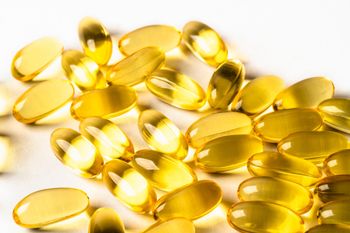
Ingredient Spotlight: S-Adenosylmethionine (SAM-e)
S-adenosylmethionine (SAM-e) is a naturally occurring compound found in every cell in the human body. SAM-e is synthesized from adenosine triphosphate (ATP) and the amino acid methionine.
S-adenosylmethionine (SAM-e) is a naturally occurring compound found in every cell in the human body. SAM-e is synthesized from adenosine triphosphate (ATP) and the amino acid methionine.
SAM-e is involved in numerous biochemical pathways in the body, most of which involve its role as a methyl group donor. Although regulated as a prescription drug in Europe, SAM-e is available in the United States as a nutritional supplement. With a long history of clinical efficacy in treating depression, SAM-e has also been shown to support healthy liver function as well as be an effective therapy for osteoarthritis.(1-3)
SAM-e and Depression
Depression is a significant public health concern, affecting as many as 35 million Americans. Current treatments for depression include medication and psychotherapy. The problem is, most all antidepressant medications are not without side effects, some serious.
SSRIs (Selective Serotonin Reuptake Inhibitors) began being prescribed for depression back in the late 1980s. A major problem with these antidepressant drugs is that they fail a significant number of patients-up to 30%. In many cases, the drugs make depressed individuals feel worse, and FDA-mandated labeling now requires a warning that use of some antidepressants increases suicide risk.(4,5)
Maurizio Fava, MD, vice chair of the department of psychiatry and director of the Depression Clinical and Research Program (DCRP) at Massachusetts General Hospital, noted in a recently published study that the majority of depressed patients will not experience remission when treated with a first-line antidepressant. Basically, antidepressants will not work for most people with treatment-resistant depression.(6)
One very effective and safe alternative to traditional antidepressant medications is SAM-e. SAM-e is derived from the amino acid methionine through a metabolic pathway called the one-carbon cycle. Methionine metabolism requires the B-vitamins folic acid and vitamin B12 (there is a relationship between levels of these nutrients and depression).(7, 8)
SAM-e, as a methyl donor, enables the brain to manufacture vital neurotransmitters, including dopamine, serotonin, and norepinephrine, from substrate molecules. Methyl groups are chemical groups-one carbon atom and three hydrogen atoms-that help modify the biological functions of various molecules. By donating a methyl group to DNA, SAM-e regulates production of important proteins involved in everything from immune function to cellular growth and repair.
Clinical studies on depression have demonstrated the efficacy of SAM-e when either compared to, or given in conjunction with, prescription antidepressants. SAM-e has been used successfully in various populations, including those individuals who do not respond to antidepressants and those who experience significant side effects. In head-to-head comparisons, SAM-e has been shown to perform as well as, if not better than, tricyclic antidepressants, in some studies increasing their onset of action.(9-11)
Most recently, researchers at Harvard Medical School and Massachusetts General Hospital gave patients 800 mg of SAM-e twice daily along with their current SSRI (such as Paxil, Prozac, Zoloft, etc.). Those who received SAM-e experienced a 36.1% response rate and a 25.8% remission rate, compared to a 17.6% and an 11.7% response and remission rate, respectively, in the placebo group.
SAM-e can also help improve memory-related cognitive symptoms in depressed patients.(12) The extensive safety and efficacy profile of SAM-e should encourage more physicians to use it as part of a treatment protocol for individuals who suffer from minor or major depression.
SAM-e and Liver Health
SAM-e plays some very important roles in healthy liver function. Due to its content of sulfur, SAM-e is involved in transsulfuration reactions in the liver. These reactions support the liver’s production of the body’s most powerful natural antioxidant, glutathione.(13)
Glutathione, in addition to serving as the body’s “master” antioxidant, plays a major role in liver detoxification. In the liver, glutathione helps neutralize dangerous toxins by converting them into forms that are easier for the body to excrete. (SAM-e may also help support glutathione production in individuals with liver disease.)(14)
Given the importance of SAM-e to overall liver function, most methionine in the liver is converted to SAM-e. Oral SAM-e has been shown to increase glutathione levels in the liver and red blood cells of both individuals with and without liver disease, and has been used to treat a variety of liver pathologies, including hepatitis, cholestasis, obstructive jaundice, alcoholic liver disease, and cirrhosis.(15-17) SAM-e may also provide benefits in the area of liver cancer.(18)
SAM-e and Joint Health
SAM-e not only benefits the brain and liver, but also serves as an effective intervention for osteoarthritis.
Osteoarthritis is the most common form of arthritis, affecting 15% of Americans at an annual cost of $95 billion. Unlike analgesics and anti-inflammatories such as aspirin and ibuprofen, or the prescription drugs Celebrex and Bextra, SAM-e not only reduces the joint inflammation associated with osteoarthritis, but it may also reverse the cartilage degeneration that causes the inflammation.
While anti-inflammatory drugs provide temporary relief from joint pain, there is no conclusive evidence that they stop the tissue degeneration that is the root cause of osteoarthritic pain and inflammation. In fact, evidence suggests that some anti-inflammatories may actually hinder healing. SAM-e increases proteoglycan synthesis and proliferation rate, thus providing chondroprotective effects.(19) Proteoglycans attract and hold water, and water is crucial to healthy functioning cartilage.
Researchers at the University of Maryland published a meta-analysis of randomized controlled trials of SAM-e versus placebo or nonsteroidal anti-inflammatories (NSAIDs), such as aspirin or ibuprofen, in the treatment of osteoarthritis. The researchers concluded that SAM-e “appears to be as effective as NSAIDs in reducing pain and improving functional limitation in patients with osteoarthritis, without the adverse effects often associated with NSAID therapy.”(20)
Given that NSAID use is associated with potentially serious side effects such as gastrointestinal bleeding, NSAIDs may not be the best choice for the treatment of chronic arthritis pain. Italian researchers recently reported that symptoms of stomach-intestinal upset due to NSAIDs are estimated to be 10 to 30 times the number affecting the general population.(21) Short-term, double-blind clinical trials have shown that SAM-e is more effective than a placebo and equally as effective as naproxen, ibuprofen, piroxicam, celecoxib (Celebrex), and indomethacin in the management of symptoms of osteoarthritis, with fewer side effects.(22-27)
A 24-month multicenter open trial found that subjects who supplemented with 400 mg per day of SAM-e showed improvement over two years-and with excellent long-term tolerance. Study subjects showed clinical improvement after two weeks and continued to improve until the end of the study, when 18% of the patients were symptom free.(28)
More long-term clinical studies are needed to establish SAM-e as a first-line therapy for osteoarthritis and, perhaps, even other inflammatory and degenerative-related conditions (i.e., rheumatoid arthritis).
The Data Is Available
With the support of numerous research studies, SAM-e has demonstrated significant safety and efficacy in several of the most common conditions for which alternative treatment options may be desired. With millions of Americans suffering from depression, arthritis, and liver disease, SAM-e should be considered by physicians as part of a treatment protocol for these conditions.
The commonly prescribed medications for these conditions carry with them a significant number of side effects, many of which could eventually lead to noncompliance. By contrast, SAM-e has been shown to enhance some of the benefits of these medications, and, in most cases, to perform as well as-if not better than-medication alone.
The data supporting SAM-e is available. However, as always, it’s up to a patient and his or her healthcare practitioner to take the time to review this information. Even though more physicians are recommending SAM-e, it is still not utilized as often as it should be, considering its long history of safe use and efficacy.
References
- Mischoulon D, Fava M. Role of S-adenosyl-L-methionine in the treatment of depression: a review of the evidence. Am J Clin Nutr 2002:76:1158s-1161s.
- Mato J, Lu S. Role of s-adenosyl-L-methionine in liver health and injury. Hepatology 2007;45:1306-1312.
- Najim W., et al. S-adenosyl methionine (SAM-e) versus celecoxib for the treatment of osteoarthritis symptoms: a double-blind crossover trial. BMC Musculoskelet Disord 2004;5:1-15.
- Zohar J, et al. Do SSRI’s or antidepressants in general increase suicidality. WPA section on pharmacopsychiatry. Consensus statement. European Archives of Psychiatry and Clinical Sciences 2008;258:3-23.
- Akisaki H, Rihmer Z. Do antidepressants threaten depressives? Toward a clinically judicious formulation of the antidepressant-suicidality FDA advisory in light of declining national suicide statistics from many countries. J Affect Disord 2006;94:3-13.
- Fava M. Switching treatments for complicated depression. J Clin Psychiatry 2010;71:e-04.
- Ng T, et al. Folate, vitamin B12, homocysteine and depressive symptoms in a population sample of older Chinese adults: Brief reports. Journal of The American Geriatrics Society 2009;57:871-876.
- Papakostas GI, Petersen T, Mischoulon D, et al. Serum folate, vitamin B12, and homocysteine in major depressive disorder, Part 2: predictors of relapse during the continuation phase of pharmacotherapy. J Clin Psychiatry. 2004;65:1096-8.
- Bressa GM. S-adenosyl-l-methionine (SAM-e) as antidepressant: meta-analysis of clinical studies. Acta Neurol Scand Suppl. 1994;154:7-14.
- Delle Chiaie R, Pancheri P, Scapicchio P. Efficacy and tolerability of oral and intramuscular S-adenosyl-L-methionine 1,4-butanedisulfonate (SAM-e) in the treatment of major depression: comparison with imipramine in 2 multicenter studies. Am J Clin Nutr. 2002 Nov;76(5):1172S-6S.
- Berlanga C, Ortega-Soto HA, Ontiveros M, Senties H. Efficacy of S-adenosyl-L-methionine in speeding the onset of action of imipramine. Psychiatry Res. 1992 Dec;44(3):257-62.
- Papakostas G, et al. Effects of S-adenosylmethionine augmentation of serotonin-reuptake inhibitor antidepressants on cognitive symptoms of major depressive disorder. Journal of Affective Disorders, in press, corrected proof.
- Mato JM, Corrales FJ, Lu SC, Avila MA. S-Adenosylmethionine: a control switch that regulates liver function. FASEB J. 2002 Jan;16(1):15-26.
- Vendemiale G, et al. Effects of oral S-adenosyl-L-methionine on hepatic glutathione in patients with liver disease. Scand J Gastroenterol 1989;24:407-414.
- S-Adenosyl-L-methionine administration on red blood cell cysteine and glutathione levels in alcoholic patients with and without liver disease. Alcohol. 1994;29:597-604.
- Frezza M, et al, Prevention by S-adenosylmethionine of estrogen-induced hepatobiliary toxicity in susceptible women. Am J Gastroenterol 1988; 83:1098-1102.
- Lieber C. S-Adenosyl-L-methionine and alcoholic liver disease in animal models: Implications for early intervention in human beings. Alcohol 2002;27:173-177.
- Pascale RM, Simile MM, De Miglio MR, Feo F. Chemoprevention of hepatocarcinogenesis: S-adenosyl-L-methionine. Alcohol. 2002 Jul;27(3):193-8.
- Harmand MF, Vilamitjana J, Maloche E, Duphil R, Ducassou D. Effects of S-adenosylmethionine on human articular chondrocyte differentiation. An in vitro study. Am J Med. 1987 Nov 20;83(5A):48-54.
- Soeken KL, Lee WL, Bausell RB, Agelli M, Berman BM. Safety and efficacy of S-adenosylmethionine (SAM-e) for osteoarthritis. J Fam Pract. 2002 May;51(5):425-30.
- Lazzaroni M, Bianchi Porro G. Gastrointestinal side-effects of traditional non-steroidal anti-inflammatory drugs and new formulations. Aliment Pharmacol Ther. 2004 Jul;20 Suppl 2:48-58.
- Bradley J, et al. A randomized, double blind, placebo controlled trial of intravenous loading with s-adenosylmethionine (SAM-e) followed by oral SAM-e therapy in patients with knee osteoarthritis. J Rheumatol 1994;21:905–911.
- Glorioso S, Todesco S, Mazzi A. Double-blind multicentre study of the activity of s-adenosylmethionine in hip and knee osteoarthritis. Intern J Clin Pharm Res 1985;5:39-49.
- Caruso I, Pietrogrande V. Italian double-blind multicenter study comparing s-adenosylmethionine, naproxen, and placebo in the treatment of degenerative joint disease. Am J Med 1987;83:66–71.
- Maccagno A, et al. Double-blind controlled clinical trial of oral s-adenosylmethionine versus piroxicam in knee osteoarthritis. Am. J. Med 1987;83:72–77.
- Najm, W, et al. S-Adenosyl methionine (SAM-e) versus celecoxib for the treatment of osteoarthritis symptoms: A double-blind cross-over trial. BMC Musculo Dis 2004;5:6.
- Vetter, G, et al. Double-blind comparative clinical trial with s-adenosylmethionine and indomethacin in the treatment of osteoarthritis. Am J Med 1987;83:78–80.
- K¨onig, B. A long-term (two years) clinical trial with s-adenosylmethionine for the treatment of osteoarthritis. Am J Med 1987;83:89S–94S.
Newsletter
From ingredient science to consumer trends, get the intel you need to stay competitive in the nutrition space—subscribe now to Nutritional Outlook.





